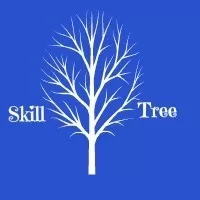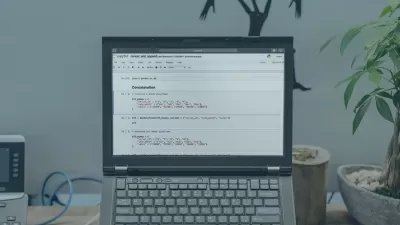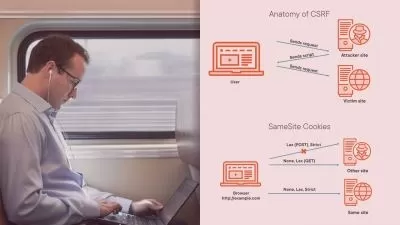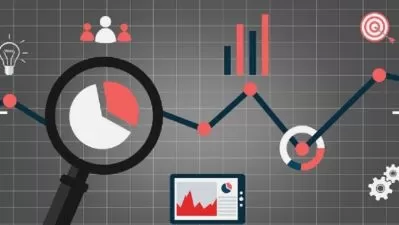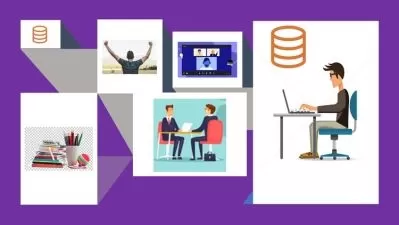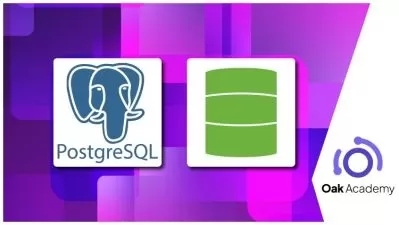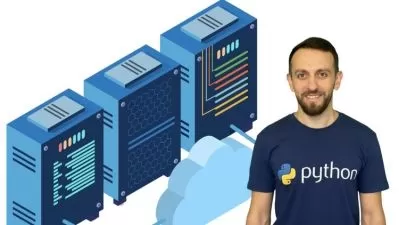PostgreSQL Databases | Python Programming(Build App and API)
Skill Tree
11:02:37
Description
Mastering Data and Code: Unleashing the Power of PostgreSQL and Python to Build Dynamic Apps and APIs
What You'll Learn?
- Installing and configuring PostgreSQL.
- Understanding the fundamental concepts of PostgreSQL databases.
- Creating PostgreSQL databases and tables.
- Understanding and utilizing PostgreSQL data types.
- Understanding the concept of CRUD (Create, Read, Update, Delete) operations.
- Performing CRUD operations in PostgreSQL.
- Understanding and utilizing table joins in PostgreSQL.
- Performing various types of PostgreSQL table joins like Inner Join, Left Join, Right Join, and Full Outer Join.
- Understanding and utilizing PostgreSQL aggregate functions like COUNT, SUM, AVG, MAX, and MIN.
- Creating and using PostgreSQL triggers for automatic database operations.
- Basic Python programming syntax and concepts.
- Understanding and using Python variables and data types.
- Implementing conditional statements in Python.
- Understanding and utilizing loops in Python.
- Writing and calling Python functions.
- Using Jupyter Notebook for Python coding and testing.
- Connecting a PostgreSQL database with a Python application.
- Performing database operations in Python using PostgreSQL.
- Understanding the structure of a database-driven Python application.
- Designing and building a database-driven Python application.
- Introduction to API and their importance.
- Basics of the Django framework and Django REST Framework.
- Building APIs using Django and Django REST Framework.
- Connecting an API to a PostgreSQL database.
- Making API calls from a Python application.
- Understanding the principles of the REST architecture.
- Testing and debugging a Python application connected to a PostgreSQL database.
Who is this for?
What You Need to Know?
More details
DescriptionDive deep into the world of Python programming and PostgreSQL databases with our comprehensive course designed to take you from beginner to expert. In this dynamic and engaging course, you will learn the essential concepts and practices used by professional programmers and database administrators worldwide.
This course begins by guiding you through the PostgreSQL Setup, introducing you to the world of relational databases. You will gain a solid understanding of PostgreSQL Database Fundamentals, including database schemas, data types, and relationships.
Once you're comfortable with the basics, we'll venture into Performing PostgreSQL CRUD Operations, where you'll learn how to Create, Read, Update, and Delete data in your PostgreSQL databases. You'll then discover the power of PostgreSQL Table Joins, which allow you to combine data from multiple tables in powerful and insightful ways.
We'll also delve into advanced SQL concepts, including PostgreSQL Aggregate Functions for summarizing data, and PostgreSQL Triggers which allow automatic actions based on database events.
Shifting gears, we'll introduce you to Python, one of the world's most popular and powerful programming languages. You will get hands-on experience with Performing basic Python operations like Loops, conditional statements, Variables, and functions with Jupyter Notebook. This knowledge will form the foundation for all your Python programming.
The course then merges these two powerful tools – Python and PostgreSQL. You will learn how to Build a database-driven application with PostgreSQL and Python, enabling you to create dynamic and interactive web applications.
Lastly, you'll enter the world of APIs. Building an API with Python, Django, PostgreSQL, and the REST Framework will be the final step in your journey. This will allow your applications to communicate with other applications, providing powerful and flexible functionality.
By the end of the course, you will have a thorough understanding of Python programming and PostgreSQL databases, and you will be able to create sophisticated web applications and APIs. Whether you're just starting your coding journey or looking to enhance your skills, this course will provide the knowledge and experience you need to succeed.
Who this course is for:
- Beginner Programmers: Individuals who are starting their journey in programming and want to learn Python and PostgreSQL. This course provides foundational knowledge in Python and database management with PostgreSQL.
- Experienced Programmers: Those already familiar with programming concepts but want to expand their knowledge into Python and PostgreSQL. This course can act as an efficient refresher or skill enhancer.
- Database Administrators: Those who want to gain or enhance their understanding of PostgreSQL, including CRUD operations, table joins, triggers, and aggregate functions.
- Web Developers: Those looking to build database-driven applications and APIs using Python, Django, and PostgreSQL. This course covers the use of Django REST Framework, which is widely used for API development.
- Data Analysts and Data Scientists: Those who work with data regularly and want to enhance their data retrieval and manipulation skills using PostgreSQL. Python is also widely used in data analysis and machine learning, making this a good course for data professionals.
- Career Changers: Individuals looking to shift their career into the tech industry, especially into roles such as software development, web development, or database administration.
- IT Professionals: Those who wish to upskill by learning a modern programming language like Python and a robust database system like PostgreSQL.
- Students: Those studying computer science or a related field, seeking to augment their academic knowledge with practical skills in Python and PostgreSQL.
- This course is designed to cater to a broad spectrum of learners, ranging from beginners to experienced professionals looking to upgrade their skills or transition into new roles.
Dive deep into the world of Python programming and PostgreSQL databases with our comprehensive course designed to take you from beginner to expert. In this dynamic and engaging course, you will learn the essential concepts and practices used by professional programmers and database administrators worldwide.
This course begins by guiding you through the PostgreSQL Setup, introducing you to the world of relational databases. You will gain a solid understanding of PostgreSQL Database Fundamentals, including database schemas, data types, and relationships.
Once you're comfortable with the basics, we'll venture into Performing PostgreSQL CRUD Operations, where you'll learn how to Create, Read, Update, and Delete data in your PostgreSQL databases. You'll then discover the power of PostgreSQL Table Joins, which allow you to combine data from multiple tables in powerful and insightful ways.
We'll also delve into advanced SQL concepts, including PostgreSQL Aggregate Functions for summarizing data, and PostgreSQL Triggers which allow automatic actions based on database events.
Shifting gears, we'll introduce you to Python, one of the world's most popular and powerful programming languages. You will get hands-on experience with Performing basic Python operations like Loops, conditional statements, Variables, and functions with Jupyter Notebook. This knowledge will form the foundation for all your Python programming.
The course then merges these two powerful tools – Python and PostgreSQL. You will learn how to Build a database-driven application with PostgreSQL and Python, enabling you to create dynamic and interactive web applications.
Lastly, you'll enter the world of APIs. Building an API with Python, Django, PostgreSQL, and the REST Framework will be the final step in your journey. This will allow your applications to communicate with other applications, providing powerful and flexible functionality.
By the end of the course, you will have a thorough understanding of Python programming and PostgreSQL databases, and you will be able to create sophisticated web applications and APIs. Whether you're just starting your coding journey or looking to enhance your skills, this course will provide the knowledge and experience you need to succeed.
Who this course is for:
- Beginner Programmers: Individuals who are starting their journey in programming and want to learn Python and PostgreSQL. This course provides foundational knowledge in Python and database management with PostgreSQL.
- Experienced Programmers: Those already familiar with programming concepts but want to expand their knowledge into Python and PostgreSQL. This course can act as an efficient refresher or skill enhancer.
- Database Administrators: Those who want to gain or enhance their understanding of PostgreSQL, including CRUD operations, table joins, triggers, and aggregate functions.
- Web Developers: Those looking to build database-driven applications and APIs using Python, Django, and PostgreSQL. This course covers the use of Django REST Framework, which is widely used for API development.
- Data Analysts and Data Scientists: Those who work with data regularly and want to enhance their data retrieval and manipulation skills using PostgreSQL. Python is also widely used in data analysis and machine learning, making this a good course for data professionals.
- Career Changers: Individuals looking to shift their career into the tech industry, especially into roles such as software development, web development, or database administration.
- IT Professionals: Those who wish to upskill by learning a modern programming language like Python and a robust database system like PostgreSQL.
- Students: Those studying computer science or a related field, seeking to augment their academic knowledge with practical skills in Python and PostgreSQL.
- This course is designed to cater to a broad spectrum of learners, ranging from beginners to experienced professionals looking to upgrade their skills or transition into new roles.
User Reviews
Rating
Skill Tree
Instructor's Courses
Udemy
View courses Udemy- language english
- Training sessions 99
- duration 11:02:37
- Release Date 2023/07/05





